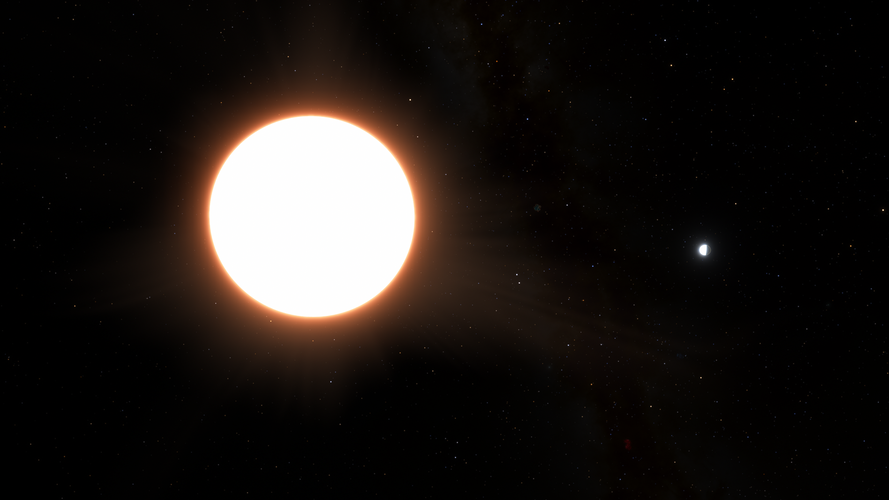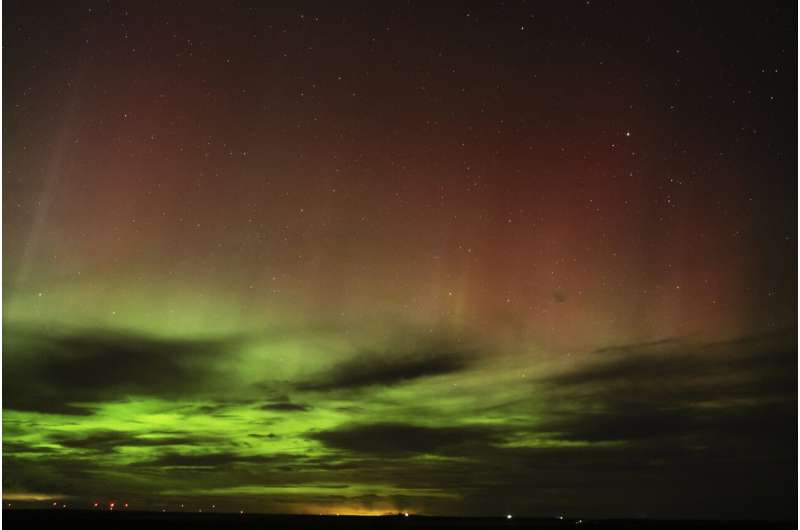
Copernical Team
Cheops shows scorching exoplanet acts like a mirror

Data from ESA’s exoplanet mission Cheops has led to the surprising revelation that an ultra-hot exoplanet that orbits its host star in less than a day is covered by reflective clouds of metal, making it the shiniest exoplanet ever found.
Solar storm on Thursday expected to make Northern Lights visible in 17 states

AI robots at UN reckon they could run the world better
 A panel of AI-enabled humanoid robots told a United Nations summit on Friday that they could eventually run the world better than humans.
But the social robots said they felt humans should proceed with caution when embracing the rapidly-developing potential of artificial intelligence.
And they admitted that they cannot - yet - get a proper grip on human emotions.
Some of the most a
A panel of AI-enabled humanoid robots told a United Nations summit on Friday that they could eventually run the world better than humans.
But the social robots said they felt humans should proceed with caution when embracing the rapidly-developing potential of artificial intelligence.
And they admitted that they cannot - yet - get a proper grip on human emotions.
Some of the most a No additional radiation at cruising altitude off the coast of Brazil
 Earth's atmosphere protects aircraft passengers and crew from the effects of the South Atlantic Anomaly. At cruising altitude, there is no additional exposure to cosmic radiation off the coast of Brazil. This was confirmed by a German Aerospace Center research team during measurement flights. The results of the study, conducted as Atlantic Kiss mission, have now been published in a scientific jo
Earth's atmosphere protects aircraft passengers and crew from the effects of the South Atlantic Anomaly. At cruising altitude, there is no additional exposure to cosmic radiation off the coast of Brazil. This was confirmed by a German Aerospace Center research team during measurement flights. The results of the study, conducted as Atlantic Kiss mission, have now been published in a scientific jo ATLAS Space launches Freedom Space for Government Missions
 ATLAS Space Operations, a front-runner in Ground Software as a Service (GSaaS) provision, is broadening its reach with the inauguration of its subsidiary, Freedom Space Technologies. This development emphasizes ATLAS's resolve to enhance space industry capabilities and support the execution of vital government missions.
The new subsidiary will be based in Colorado Springs, CO, and aims to
ATLAS Space Operations, a front-runner in Ground Software as a Service (GSaaS) provision, is broadening its reach with the inauguration of its subsidiary, Freedom Space Technologies. This development emphasizes ATLAS's resolve to enhance space industry capabilities and support the execution of vital government missions.
The new subsidiary will be based in Colorado Springs, CO, and aims to Space Act Agreement with NASA will advance UArizona engagement in human spaceflight
 An agreement with the Johnson Space Center will allow the University of Arizona to be substantially involved in human spaceflight expeditions. The University of Arizona recently signed a Space Act Agreement with NASA's Johnson Space Center that will allow the university to engage extensively in human spaceflight missions.
The agreement will take the university's current association with NA
An agreement with the Johnson Space Center will allow the University of Arizona to be substantially involved in human spaceflight expeditions. The University of Arizona recently signed a Space Act Agreement with NASA's Johnson Space Center that will allow the university to engage extensively in human spaceflight missions.
The agreement will take the university's current association with NA Rise of the robots: UN tries to tackle 'mind-blowing' growth of AI
 The mind-blowing growth of artificial intelligence poses many questions that have no answers yet, the United Nations admitted Thursday at its AI summit, attended by some exceptionally life-like humanoid robots.
The UN is aware that AI technology is racing ahead of the capacity to set its boundaries and directions, and so it brought together some of the best minds on the topic - whether huma
The mind-blowing growth of artificial intelligence poses many questions that have no answers yet, the United Nations admitted Thursday at its AI summit, attended by some exceptionally life-like humanoid robots.
The UN is aware that AI technology is racing ahead of the capacity to set its boundaries and directions, and so it brought together some of the best minds on the topic - whether huma NASA humanoid robot to be tested in Australia
 Houston TX (SPX) Jul 08, 2023
NASA's Valkyrie robot is beginning a new mission half a world away from its home at the agency's Johnson Space Center in Houston. As part of a reimbursable Space Act Agreement with Woodside Energy in Perth, Western Australia, NASA plans to use a Valkyrie robot to develop remote mobile dexterous manipulation capabilities to accommodate remote caretaking of uncrewed
Houston TX (SPX) Jul 08, 2023
NASA's Valkyrie robot is beginning a new mission half a world away from its home at the agency's Johnson Space Center in Houston. As part of a reimbursable Space Act Agreement with Woodside Energy in Perth, Western Australia, NASA plans to use a Valkyrie robot to develop remote mobile dexterous manipulation capabilities to accommodate remote caretaking of uncrewed Astronomers discover elusive planet responsible for spiral arms around its star
 Depictions of the Milky Way show a coiling pattern of spiral "arms" filled with stars extending outward from the center. Similar patterns have been observed in the swirling clouds of gas and dust surrounding some young stars - planetary systems in the making. These so-called protoplanetary disks, which are the birthplaces of young planets, are of interest to scientists because they offer glimpse
Depictions of the Milky Way show a coiling pattern of spiral "arms" filled with stars extending outward from the center. Similar patterns have been observed in the swirling clouds of gas and dust surrounding some young stars - planetary systems in the making. These so-called protoplanetary disks, which are the birthplaces of young planets, are of interest to scientists because they offer glimpse Heading toward a cluster of craters: Sols 3880-3881
 While many of us were up late watching fireworks here on Earth, Curiosity wrapped up a very busy weekend on Mars. The team was pleased that our four-sol plan over the 4th of July holiday executed as expected, but planning today was unusual because the new images of the terrain in front of the rover could not be loaded into our planning software. Although we were not able to select ChemCam and Ma
While many of us were up late watching fireworks here on Earth, Curiosity wrapped up a very busy weekend on Mars. The team was pleased that our four-sol plan over the 4th of July holiday executed as expected, but planning today was unusual because the new images of the terrain in front of the rover could not be loaded into our planning software. Although we were not able to select ChemCam and Ma 































